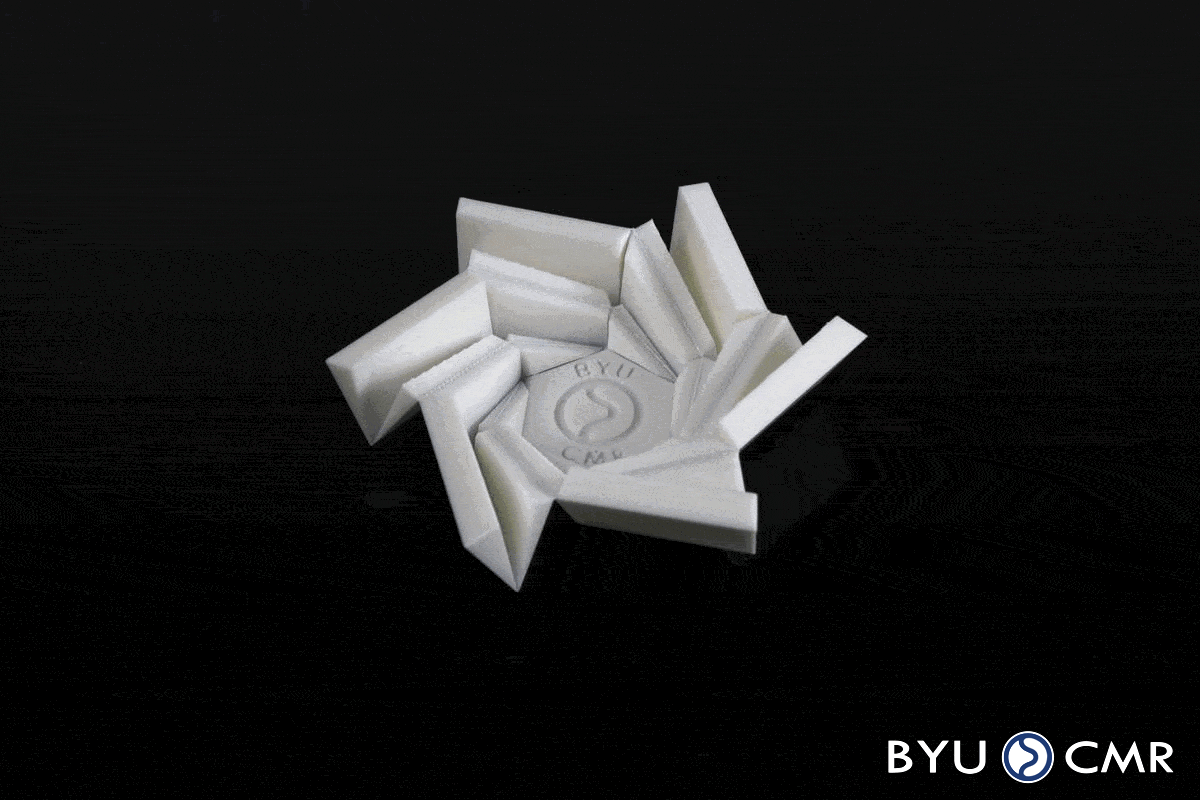
Folding Origami Flasher Hexagon with Living Hinges
prusaprinters
SummaryThis is a 3D-printable flasher pattern based on the work of Shannon Zirbel, Robert Lang, and several others. It demonstrates the ability of the flasher pattern to go from a flat state to a much more compact, folded state, all while moving with a single degree of freedom. Printing InstructionsThis model is best printed in PETG, or some other similarly flexible material. We printed it in PLA and it was just fine. The model, at its current scaling, is intended to be printed with two 0.1mm layers as the base. This ensures that all folds have something close to two orthogonal layers of filament on which to bend (printing with a single 0.2mm thick bottom layer will mean that at least two of the hinges will break very easily. See this post for a tutorial on how to make your own living hinges). Here is a tutorial on how to modify individual layer heights in PrusaSlicer.It's best to remove your print from the build plate sooner rather than later: the residual heat from the plate will help you bend the creases into the model (see this video for which directions to bend them in).You're welcome to experiment with printing the first two layers out of a more flexible material, and then printing the remaining layers with something stiffer. PLA worked fine for the three demos we made. How to Bias the Hinges Post-PrintWhen you first take the model off the build plate, it isn't going to want to fold right away. You will need to go in and bend the panels (gently!) so that they begin to coil in the way shown in the gif above.It's best to remove your print from the build plate sooner rather than later: the residual heat from the plate will help you bend the creases into the model (see the video below for which directions to bend them in).Being gentle, and looking at the flasher from above (the side with all the panels), select one of the six big triangular sections and bend the thin creases up, and the thick creases down. The thin grooves spiraling CCW away from the hexagon will need to rise up like mountains, and the thicker grooves spiraling CCW away from the hexagon will need to sink like valleys.Don't worry too much about the shorter, thin grooves that you see spiraling CW, crossing over the others: these will basically fold themselves as you crease the major creases. AlternativeIf you find that whatever filament you have is struggling with the default model, the rigid foldable alternative may be a good choice. It includes special bisections on certain panels, allowing for a folding action that doesn't place any transverse stresses on the hinges: its deployment only involves torques about the axes. The only trade-off is that it doesn't quite have the pop that the default model has in the opening and closing sequences. ApplicationsUnfolding Solar ArrayWorking with NASA's Jet Propulsion Laboratory, a team of mechanical engineering students and faculty have designed a solar array that can be tightly compacted for launch and then deployed in space to generate power for space stations or satellites.By applying the same concepts found in this 3D flasher pattern, we hope to be able to develop future space-faring technologies that can fold and unfurl in space as needed by whatever application they are fulfilling. Learn MoreThis design was developed by the Compliant Mechanisms Research Group (CMR) from Brigham Young University (BYU). Follow us at @byucmr on Instagram, @CompliantMechanismsResearchGroup on Facebook, or visit the BYU Compliant Mechanisms Research (CMR) website to learn more about compliant mechanisms. Technical InformationFor in-depth technical information, see the following publications:Zirbel, S. A., Lang, R. J., Thomson, M. W., Sigel, D. A., Walkemeyer, P. E., Trease, B. P., Magleby, S. P., and Howell, L. L. (October 3, 2013). "Accommodating Thickness in Origami-Based Deployable Arrays." ASME. J. Mech. Des. November 2013; 135(11): 111005.Lang, R.J., Magleby, S.P., Howell, L.L., “Single-Degree-of-Freedom Rigidly Foldable Origami Flashers,” ASME Journal of Mechanisms and Robotics, Vol. 8, pp. 031005-1 to 03005-15, DOI: 10.1115/1.4032102, 2016.Robert Lang developed a program for Mathematica based on that paper, which was what we used to obtain the geometry for this model. A download for his program, Tessellatica, is available here: https://langorigami.com/article/tessellatica/.To learn more about compliant mechanisms in general, see the BYU Compliant Mechanisms Research (CMR) website or these books: Compliant Mechanisms, Handbook of Compliant Mechanisms Intellectual PropertyThe downloadable 3D print files provided here may be used, modified, and enjoyed for noncommercial use. To license this technology for commercial applications, contact:BYU Technology Transfer Office3760 Harold B. Lee LibraryBrigham Young UniversityProvo, UT 84602Phone: (801) 422-6266https://techtransfer.byu.edu/contact
With this file you will be able to print Folding Origami Flasher Hexagon with Living Hinges with your 3D printer. Click on the button and save the file on your computer to work, edit or customize your design. You can also find more 3D designs for printers on Folding Origami Flasher Hexagon with Living Hinges.
